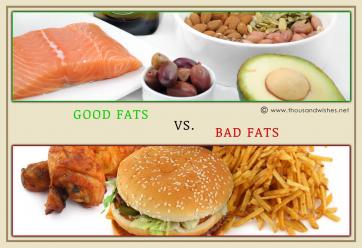 We need a certain amount of fat in our diets to stay healthy. Fats provide needed energy in the form of calories. Fats help our bodies absorb important vitamins—called fat-soluble vitamins—including vitamins A, D and E. Fats also make foods more flavorful and help us feel full. Fats are especially important for infants and toddlers, because dietary fat contributes to proper growth and development.
We need a certain amount of fat in our diets to stay healthy. Fats provide needed energy in the form of calories. Fats help our bodies absorb important vitamins—called fat-soluble vitamins—including vitamins A, D and E. Fats also make foods more flavorful and help us feel full. Fats are especially important for infants and toddlers, because dietary fat contributes to proper growth and development.
“Fats are really the most concentrated source of energy in the foods we eat, and our bodies need that energy,” says NIH nutritionist Dr. Margaret McDowell. “Fats are truly an essential nutrient.”
Problems arise, though, if we eat too much fat. Dietary fats have more than twice as many calories per gram as either proteins or carbohydrates like sugar and starch. Excess calories, of course, can pack on the pounds and raise your risk for diabetes, cancer and other conditions.
“Some fats are better for our bodies than others,” McDowell says. “We should really aim to eat the right types of fats.”
are considered “good” fats. They’re sometimes listed as “monounsaturated” and “polyunsaturated” fat on Nutrition Facts labels. These can promote health if eaten in the right amounts. They are generally liquid at room temperature, and are known as oils. You’ll find healthful unsaturated fats in fish, nuts and most vegetable oils, including canola, corn, olive and safflower oils.
The so-called “bad” fats are and . They tend to be solid at room temperature. Solid fats include butter, meat fats, stick margarine, shortening, and coconut and palm oils. They’re often found in chocolates, baked goods, and deep-fried and processed foods.
“When we eat too many solid fats, we put our bodies at risk. These fats tend to raise total blood , as well as the part of cholesterol known as low-density lipoprotein (LDL) cholesterol (bad cholesterol),” says McDowell. LDL can lead to the buildup of plaque in the arteries and cardiovascular problems.
Experts say that the total fat intake for adults ages 19 and older should be 20% to 35% of the calories eaten each day. For children ages 4 to 18, it should be 25% to 35%. Less that 10% of our fat calories should come from saturated fatty acids.
Other NIH-funded research found that, when it comes to weight loss, the source of calories—whether from fat, protein or carbohydrate—isn’t as important as the number of calories you consume. But when it comes to risk factors for heart disease, replacing some carbohydrates with protein or unsaturated fats can greatly improve blood cholesterol. In a specialized diet designed to lower blood pressure, using unsaturated fats in place of some carbohydrates boosted blood levels of “good” cholesterol (HDL cholesterol) and caused a more healthful drop in blood pressure.
Source: National Institutes of Health


 We need a certain amount of fat in our diets to stay healthy. Fats provide needed energy in the form of calories. Fats help our bodies absorb important vitamins—called fat-soluble vitamins—including vitamins A, D and E. Fats also make foods more flavorful and help us feel full. Fats are especially important for infants and toddlers, because dietary fat contributes to proper growth and development.
We need a certain amount of fat in our diets to stay healthy. Fats provide needed energy in the form of calories. Fats help our bodies absorb important vitamins—called fat-soluble vitamins—including vitamins A, D and E. Fats also make foods more flavorful and help us feel full. Fats are especially important for infants and toddlers, because dietary fat contributes to proper growth and development. Current e-cigarette use among middle and high school students tripled from 2013 to 2014, according to data published by the Centers for Disease Control and Prevention and the U.S. Food and Drug Administration’s Center for Tobacco Products (CTP). Findings from the 2014 National Youth Tobacco Survey show that current e-cigarette use (use on at least 1 day in the past 30 days) among high school students increased from 4.5 percent in 2013 to 13.4 percent in 2014, rising from approximately 660,000 to 2 million students. Among middle school students, current e-cigarette use more than tripled from 1.1 percent in 2013 to 3.9 percent in 2014—an increase from approximately 120,000 to 450,000 students.
Current e-cigarette use among middle and high school students tripled from 2013 to 2014, according to data published by the Centers for Disease Control and Prevention and the U.S. Food and Drug Administration’s Center for Tobacco Products (CTP). Findings from the 2014 National Youth Tobacco Survey show that current e-cigarette use (use on at least 1 day in the past 30 days) among high school students increased from 4.5 percent in 2013 to 13.4 percent in 2014, rising from approximately 660,000 to 2 million students. Among middle school students, current e-cigarette use more than tripled from 1.1 percent in 2013 to 3.9 percent in 2014—an increase from approximately 120,000 to 450,000 students. We are well aware that cigarette smoking has a direct link to lung cancer. Did you know that the latest Surgeon General's report identified 21 other diseases that have a causal relationship to cigarettes?
We are well aware that cigarette smoking has a direct link to lung cancer. Did you know that the latest Surgeon General's report identified 21 other diseases that have a causal relationship to cigarettes? In the last few weeks, we saw the Rolling Stone retract a highly read article about an alleged gang rape at the U of Virginia that raised a lot of questions about the ethics of journalism. In short, many of the accusations posed by the reporter were not backed up by facts and in the end cast a dark cloud over the university and the fraternities that were involved. Theconversation.com, an online news source written by academics and scholars, posted an article by Ivan Oransky, an associate professor at New York University, and Adam Marcus, that asks whether or not journalism should use the scientific method with its rigourous investigation, questioning of evidence, testing and revised hypotheses as a good model for self-correction. This article also takes a look at the scientific method itself and whether or not it, too, has some shortcomings and is vulnerable to human biases.
In the last few weeks, we saw the Rolling Stone retract a highly read article about an alleged gang rape at the U of Virginia that raised a lot of questions about the ethics of journalism. In short, many of the accusations posed by the reporter were not backed up by facts and in the end cast a dark cloud over the university and the fraternities that were involved. Theconversation.com, an online news source written by academics and scholars, posted an article by Ivan Oransky, an associate professor at New York University, and Adam Marcus, that asks whether or not journalism should use the scientific method with its rigourous investigation, questioning of evidence, testing and revised hypotheses as a good model for self-correction. This article also takes a look at the scientific method itself and whether or not it, too, has some shortcomings and is vulnerable to human biases.  Equal Pay Day is finally here! Equal Pay Day (April 14, 2015) is the symbolic day when women's earnings catch up to men's earnings for the previous year. The most recent data shows that on average for every dollar paid to a man, a woman receives 78 cents. That is one penny more than the statistic women have been stuck at for the past decade and this gap is of course even wider for women of color!
Equal Pay Day is finally here! Equal Pay Day (April 14, 2015) is the symbolic day when women's earnings catch up to men's earnings for the previous year. The most recent data shows that on average for every dollar paid to a man, a woman receives 78 cents. That is one penny more than the statistic women have been stuck at for the past decade and this gap is of course even wider for women of color!  While rare, breast cancer does affect women under the age of 45. In young women, the disease is more often hereditary than it is in older women. Young women, however, may not realize they are at risk for this disease. The Centers for Disease Control and Prevention’s (CDC) new Bring Your Brave campaign will feature young women telling their personal stories about how their lives have been affected by breast cancer. The goals of the campaign are to motivate young women to learn about the disease and its prevention, learn their family history of cancer, and engage in conversations with their health care provider.
While rare, breast cancer does affect women under the age of 45. In young women, the disease is more often hereditary than it is in older women. Young women, however, may not realize they are at risk for this disease. The Centers for Disease Control and Prevention’s (CDC) new Bring Your Brave campaign will feature young women telling their personal stories about how their lives have been affected by breast cancer. The goals of the campaign are to motivate young women to learn about the disease and its prevention, learn their family history of cancer, and engage in conversations with their health care provider. Teen childbearing can carry health, economic, and social costs for mothers and their children. Teen births in the US have declined, but still more than 273,000 infants were born to teens ages 15 to 19 in 2013. The good news is that more teens are waiting to have sex, and for sexually active teens, nearly 90% used birth control the last time they had sex. However, teens most often use condoms and birth control pills, which are less effective at preventing pregnancy when not used consistently and correctly.
Teen childbearing can carry health, economic, and social costs for mothers and their children. Teen births in the US have declined, but still more than 273,000 infants were born to teens ages 15 to 19 in 2013. The good news is that more teens are waiting to have sex, and for sexually active teens, nearly 90% used birth control the last time they had sex. However, teens most often use condoms and birth control pills, which are less effective at preventing pregnancy when not used consistently and correctly. As we learn more about sex differences, it is easy to understand why both men and women need to be included in clinical research. But why does the sex of a cell used in basic research matter? Cell lines and primary cells are often used by basic scientists in proof-of-concept experiments and when trying to figure out how biological mechanisms work. These early findings help provide valuable clues for developing new drugs, treatments and diagnostic models that eventually can be applied to humans.
As we learn more about sex differences, it is easy to understand why both men and women need to be included in clinical research. But why does the sex of a cell used in basic research matter? Cell lines and primary cells are often used by basic scientists in proof-of-concept experiments and when trying to figure out how biological mechanisms work. These early findings help provide valuable clues for developing new drugs, treatments and diagnostic models that eventually can be applied to humans.  National STD Awareness Month is not just a reminder for young folks. Older adults, including senior citizens, need to pay attention to the messages. According to the CDC, between 2007 and 2011, chlamydia cases among Americans 65 and older increased 31% and for syphilis 52%. These percentages are similar to those in the 20- to 24- age group.
National STD Awareness Month is not just a reminder for young folks. Older adults, including senior citizens, need to pay attention to the messages. According to the CDC, between 2007 and 2011, chlamydia cases among Americans 65 and older increased 31% and for syphilis 52%. These percentages are similar to those in the 20- to 24- age group.